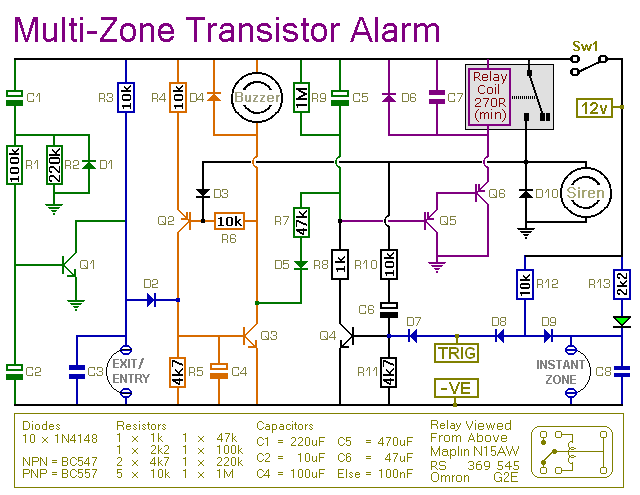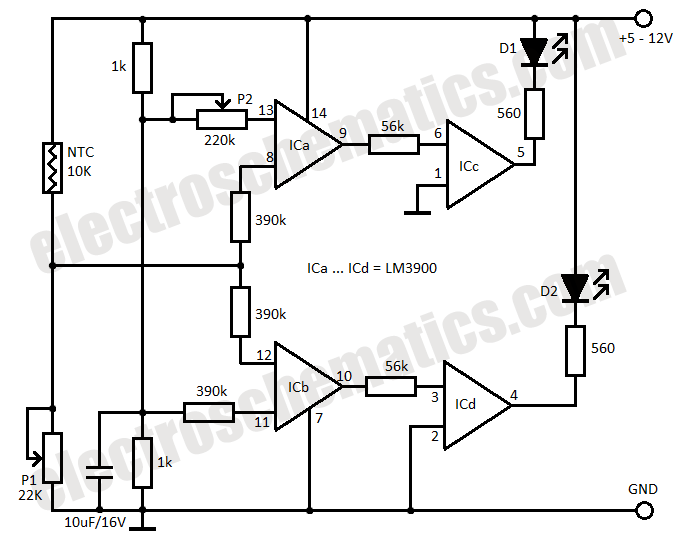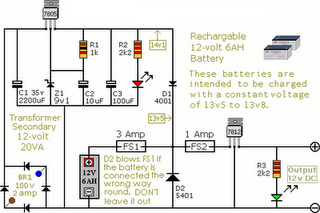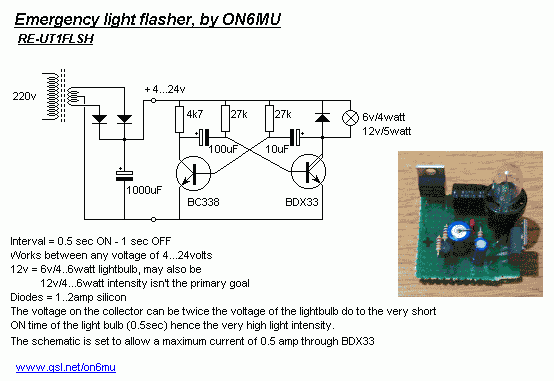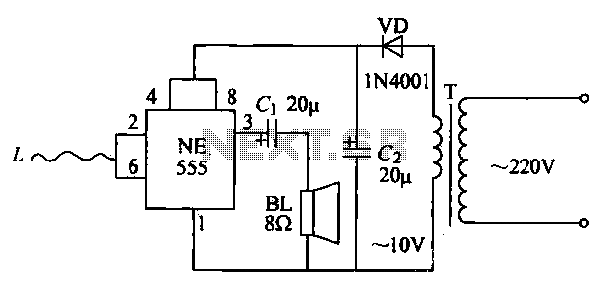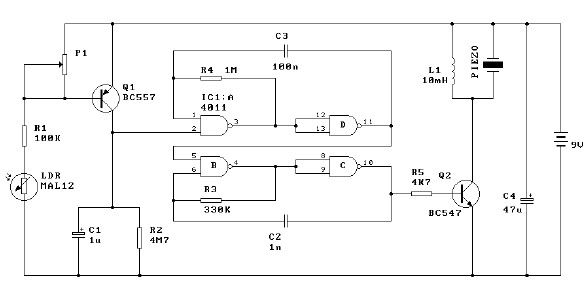
Proximity alarm

Inverters Ula and Ulb are connected in a simple RC oscillator circuit. The frequency is determined by the values of R1, C1, and C2, as well as the internal characteristics of the integrated circuit. While the circuit is oscillating, a positive DC voltage is generated at the output of the voltage-coupler circuit, which consists of C3, D1, D2, and C4. This DC voltage is applied to the input of U1c, the third inverter amplifier, maintaining its output in a low state, which keeps Q1 turned off, preventing sound production by BZ1. With C1 and C2 adjusted to the most sensitive point, the pickup plate can detect a hand positioned 3 to 5 inches away, triggering an alert.
To set up the circuit, adjust C1 and C2 to approximately one-half of their maximum value and apply power. The circuit should oscillate without producing sound. Using a non-metallic screwdriver, carefully adjust C1 and C2, one at a time, to a lower value until the circuit ceases oscillation, at which point buzzer BZ1 will sound off. Slightly increase the value of either C1 or C2 until the oscillator restarts; this configuration represents the most sensitive setting of the circuit.
The circuit operates on the principle of an RC oscillator, where the resistances and capacitances dictate the oscillation frequency. Inverters Ula and Ulb function as the primary oscillating components, while the capacitors C1 and C2 form a timing network that influences the charge and discharge cycles, thereby determining the oscillation frequency. The output from the voltage-coupler circuit, which includes capacitors C3 and diodes D1 and D2, ensures that the positive DC voltage is adequately filtered and stabilized before being fed into the third inverter U1c.
The third inverter serves as a buffer and an additional control stage, ensuring that the output remains low until the circuit is activated by the detected presence of a hand. The configuration of Q1, likely a transistor, acts as a switch that controls the buzzer BZ1. When the circuit detects the proximity of a hand, it triggers the oscillator to stop, allowing current to flow through Q1 and activating the buzzer, thus providing an audible alert.
This circuit is highly sensitive to nearby objects, making it suitable for applications such as intrusion detection or proximity sensing. Proper calibration of C1 and C2 is essential for optimal performance, allowing the circuit to react to minimal disturbances within its detection range. The use of non-metallic tools for adjustments is critical to avoid unintended interference with the circuit's operation.Inverters Ula and Ulb are connected in a simple RC oscillator circuit. The frequency is determined by the values of Rl, Cl, C2; and the internal characteristics of the integrated circuit. As long as the circuit is oscillating, a positive dc voltage is developed at the output of the voltage-coupler circuit: C3, Dl, D2 and C4.
The dc voltage is applied to the input of Ulc—the third inverter amplifier—keeping its output in a low state, which keeps Ql turned off so that no sound is produced by BZ1. With Cl and C2 adjusted to the most sensitive point, the pickup plate will detect a hand 3 to_5-inches away and sound an alert.
Set Cl and C2 to approximately one-half of their maximum value and apply power to the circuit. The circuit should oscillate and no sound should be heard. Using a non-metallic screwdriver, carefully adjust Cl and C2, one at a time, to a lower value until the circuit just ceases oscillation: Buzzer BZ1 should sound off. Back off either Cl or C2 just a smidgen until the oscillator starts up again—that is the most sensitive setting of the circuit.
To set up the circuit, adjust C1 and C2 to approximately one-half of their maximum value and apply power. The circuit should oscillate without producing sound. Using a non-metallic screwdriver, carefully adjust C1 and C2, one at a time, to a lower value until the circuit ceases oscillation, at which point buzzer BZ1 will sound off. Slightly increase the value of either C1 or C2 until the oscillator restarts; this configuration represents the most sensitive setting of the circuit.
The circuit operates on the principle of an RC oscillator, where the resistances and capacitances dictate the oscillation frequency. Inverters Ula and Ulb function as the primary oscillating components, while the capacitors C1 and C2 form a timing network that influences the charge and discharge cycles, thereby determining the oscillation frequency. The output from the voltage-coupler circuit, which includes capacitors C3 and diodes D1 and D2, ensures that the positive DC voltage is adequately filtered and stabilized before being fed into the third inverter U1c.
The third inverter serves as a buffer and an additional control stage, ensuring that the output remains low until the circuit is activated by the detected presence of a hand. The configuration of Q1, likely a transistor, acts as a switch that controls the buzzer BZ1. When the circuit detects the proximity of a hand, it triggers the oscillator to stop, allowing current to flow through Q1 and activating the buzzer, thus providing an audible alert.
This circuit is highly sensitive to nearby objects, making it suitable for applications such as intrusion detection or proximity sensing. Proper calibration of C1 and C2 is essential for optimal performance, allowing the circuit to react to minimal disturbances within its detection range. The use of non-metallic tools for adjustments is critical to avoid unintended interference with the circuit's operation.Inverters Ula and Ulb are connected in a simple RC oscillator circuit. The frequency is determined by the values of Rl, Cl, C2; and the internal characteristics of the integrated circuit. As long as the circuit is oscillating, a positive dc voltage is developed at the output of the voltage-coupler circuit: C3, Dl, D2 and C4.
The dc voltage is applied to the input of Ulc—the third inverter amplifier—keeping its output in a low state, which keeps Ql turned off so that no sound is produced by BZ1. With Cl and C2 adjusted to the most sensitive point, the pickup plate will detect a hand 3 to_5-inches away and sound an alert.
Set Cl and C2 to approximately one-half of their maximum value and apply power to the circuit. The circuit should oscillate and no sound should be heard. Using a non-metallic screwdriver, carefully adjust Cl and C2, one at a time, to a lower value until the circuit just ceases oscillation: Buzzer BZ1 should sound off. Back off either Cl or C2 just a smidgen until the oscillator starts up again—that is the most sensitive setting of the circuit.
